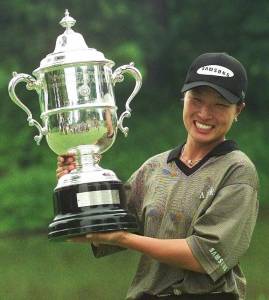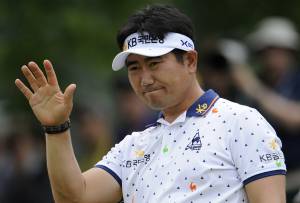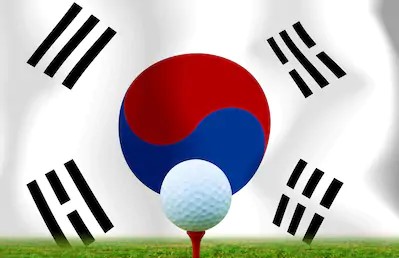LeBron James has taken his talents to southern California, Bryce Harper just signed a $330 million contract with the Philadelphia Phillies, the New England Patriots won yet another Super Bowl, and preparations for the Tokyo Summer Olympics (2020) and Qatar World Cup (2022) are well under way. All of these sports stories are interesting in their own right, but I believe they take a back seat to another one—the dominance of Koreans in women’s professional golf. Look at the leader board at virtually any tournament on the Ladies Pro Golf Association circuit, and you will find taegukki after taegukki.
Queens of their realm
Of the 500 or so fascinating facts in the Koreans’ drive to become the best in pro golf, here are a few. Since 1998, there have been only five seasons in which no Korean was named player of  the year, rookie of the year or winner of the Vare Trophy (given for the lowest average score); the country had no winners until 1998, but nine Korean women won 64 events over the next decade; 15 of the LPGA’s 33 tournaments in 2017 were won by Koreans, including three of the five majors; Korean golf fans who expected to see a sweep at the Rio Summer Olympics had to settle for gold (Inbee Park) and silver (Lydia Ko, Korea-born but now a citizen of New Zealand); between 2008 and 2017, Koreans or women of Korean descent won the U.S. Open eight times; through the end of 2018, Korean women had won a total of 29 major tournaments; six of the top 10 money winners so far in 2019 are Korean; and one recent ranking of female pro golfers showed 44 out of 100 being either from Korea or of Korean descent.
the year, rookie of the year or winner of the Vare Trophy (given for the lowest average score); the country had no winners until 1998, but nine Korean women won 64 events over the next decade; 15 of the LPGA’s 33 tournaments in 2017 were won by Koreans, including three of the five majors; Korean golf fans who expected to see a sweep at the Rio Summer Olympics had to settle for gold (Inbee Park) and silver (Lydia Ko, Korea-born but now a citizen of New Zealand); between 2008 and 2017, Koreans or women of Korean descent won the U.S. Open eight times; through the end of 2018, Korean women had won a total of 29 major tournaments; six of the top 10 money winners so far in 2019 are Korean; and one recent ranking of female pro golfers showed 44 out of 100 being either from Korea or of Korean descent.
The Korean golfing boom, among women at least, is usually traced to 1998 when Se-ri Pak won the U.S. Open, another major and two more tourneys. Although there is no doubt that Pak changed the sports dynamic here in Korea, what she did was not completely out of the blue. The LPGA of Korea began in 1978, following the lead of the LPGA of Japan (1968). We should remember that Ok Hee-ku won an LPGA event in Phoenix in 1988; Pak would also win there in 2003.
Se-ri kids
Pak, a native of Daejeon who won 39 tourneys before retiring in 2016, is the key. Other girls and young women—calling themselves “Se-ri kids”—were inspired and began working assiduously. With support from their parents, state-sponsored golf academies and corporate sponsors, they rose up and conquered the sport. One  reason their achievement is so stunning is that Korea had no golf culture or history half a century ago. The Americans and Europeans were assumed to have a permanent lock on golfing success. Furthermore, where was there to play? Korea had few golf courses (there are now about 450, roughly the number you will find in the state of Indiana alone), and playing a round was quite costly. They found alternative ways of mastering the game with indoor and outdoor driving ranges, high-tech screen golf and putting greens.
reason their achievement is so stunning is that Korea had no golf culture or history half a century ago. The Americans and Europeans were assumed to have a permanent lock on golfing success. Furthermore, where was there to play? Korea had few golf courses (there are now about 450, roughly the number you will find in the state of Indiana alone), and playing a round was quite costly. They found alternative ways of mastering the game with indoor and outdoor driving ranges, high-tech screen golf and putting greens.
The evolution of a three-tiered golfing circuit has made an appreciable difference. The Jump Tour, for girls between 10 and 16, currently has 16 events. Make the grade, and you move to the Dream Tour which has 22 events. Big time in this country is the KLPGA Tour, consisting of 32 events and more than $22 million in prize money. These tournaments, which get widespread media attention in Korea, are cut-throat competitive. By the time a young woman has survived the Jump Tour, the Dream Tour and the KLPGA Tour, she is a seasoned veteran with excellent golfing ability and nerves of steel. She is ready to try her luck in the USA, and luck seldom has anything to do with it.
Success has bred success, leading to a deep talent pool. One observer claims there are between 3,000 and 4,000 “high-performance” female golfers in Korea. Their ascension to the top of the field is now an accomplished fact, and one is  no longer surprised to see a Korean golfer hoisting the trophy after the final round of a big event in America, Europe or Japan. Few doubt that Korean women will continue to rip up the links.
no longer surprised to see a Korean golfer hoisting the trophy after the final round of a big event in America, Europe or Japan. Few doubt that Korean women will continue to rip up the links.
(I will stop here and address an unpleasant issue. There is some degree of resentment on the part of American and European players about how Asians—especially Koreans—have taken over women’s golf. Jessica Korda and the now-retired Jan Stephenson have bemoaned it. Stephenson, an Australian who lives in Florida, said, “The Asians are killing our tour” and even suggested that their numbers be limited by means of a quota. She knew she would get whipsawed for saying that, and she was. An apology followed quickly.)
Mad for golf
One may fairly ask why the Korean men do not replicate the staggering success of the women. Only three Koreans are currently in the top 100 PGA rankings. If I may generalize, it has to do with physical power. The women play shorter courses, and so driving distance is less important. Indeed, if you check the top ten drivers in women’s pro golf, none are Korean. So the showing by male golfers like K.J. Choi, Kim Si-woo and Yang Yong-eun is all the more impressive.
Korea is today a golf-mad country. Some highly focused kids get up at 5 a.m. so they can spend an hour hitting balls before going to school. The final round of the KEB Hana Bank tourney in 2018 (won by Chun In-gee) drew 38,000 boisterous spectators to the Sky 72 Golf Club in Incheon; the Americans, Brits, Canadians, Swedes, Aussies, et al. could hardly believe it. There are 3 million regular players in Korea, male and female, and 9,000 accredited coaches. The driving ranges, screen-golf establishments and putting greens I referred to earlier are packed, TV ratings are high, pro players have enthusiastic fan clubs, and the number of courses continues to grow.


12 Comments
Richard, I am fascinated by your insight in Korean female golf phenomenon.
I think why Korean women is going so strong in world class golf tournaments is in part due to their early start.
World class Korean female golfers usually start their golf lesseons when they are 5 or 6 years old.
In many cases, they are pushed to take golf lessons by their parents and it is very difficult to deny parents’ guidance in Korea, especially in the cases of little girls.
Korean boys take lessons in more diverse fields like soccer, judo or speed skating and this could partially explain why Korean boys are not as impressive as girls in golf.
In China, only 3 or 4 year old girls are urged to take gymnastics or diving lessons whether they really like it or not.
I think this is also one of the reasons why China is doing so well gymnastics and in diving in Olympics and other world stage games.
This is just my intuitive thought as I don’t play golf, I am also curious about Korean women golfers excellence in world stage.
I am waiting for your next interesting story.
Matthew, my dear sir, thank you for reading this story and making a pertinent comment. As is probably clear, I find the story of Koreans ruling the women’s pro golf world nothing short of incredible.
What a brilliant article about Korean woman golfers. You don’t start to write until you have gather all informations about your writing. And your reader can’t stop finish reading it. You gathered all informations about the story you are writing. You are great researcher. You are great writer. And you are great columnist, too.
Five film crewmen are coming all the way from Paris to cover your story about ‘Jikji Must Return to Korea.’ I can’t wait the crew. French people are more interested in Jikji than Koreans. Shame!
Mr. Yoon, thanks for the kind words. What you say is true–I gathered information and studied it for a month before I started writing this article. And then there came the re-writing and polishing, along with more researching. It’s a long process but one I enjoy. Yes, the interviews with those young Frenchmen and -women will be interesting. I want you there!
Whatever the reasons I enjoy outstanding golf from men and women. Korean women have become so dominating in golf and will continue to excel. I have my favorites and watch for them all the time. It helps that my favorites are usually near the top of the leaderboard.
Coach, I wonder who your favorites might be—Inbee Park? Ryu So-hyeon? Maybe Park Sung-hyeon or Chung In-gee or Amy Yang or Meena Lee or Kim Mi-hyun?? All of them are great!
Richard-I don’t play or follow golf, but I found the article fascinating-I had no idea of the Korean women golf phenomenon. Kevin
I keep up with golf about as much as you do, Kevin. But this Korean women thing is hard to believe…
I love sports and have been active my whole life with baseball, basketball, football, snowboarding, golf and more. The success of Korean women in golf is pretty amazing and I think it’s fantastic!! Anyone who is competitive wants to face the best competition possible not only because it elevates your level of play, but when you do win it’s even more gratifying. This article was a great read!
Well, thank you, Joe. I really appreciate that (and I agree with your points).
Interesting article. However, I was a bit taken aback when you lumped Jessica Korda in with Jan Stephenson “bemoaning” the success of the Asian golfers. I am not aware of any negative comments from Ms. Korda … other than the pointing out the absence of a good developmental program in the States like they have in Korea and which you reference above. See the link below.
https://www.golf.com/travel/2018/08/01/jessica-korda-korean-lpga-dominance/
No need to be taken aback or anywhere else. This story is about Korean female golfers and how they have achieved success against all odds. Korda and other American girls have had all the advantages, but they now fall behind. If having a 3-tier development program is all there is to it, the Americans should implement one of their own. Then they will be back on top–right?
Add Comment